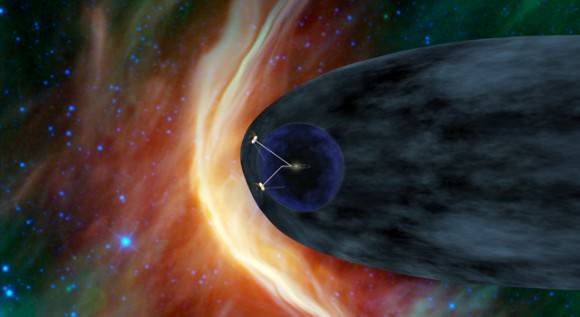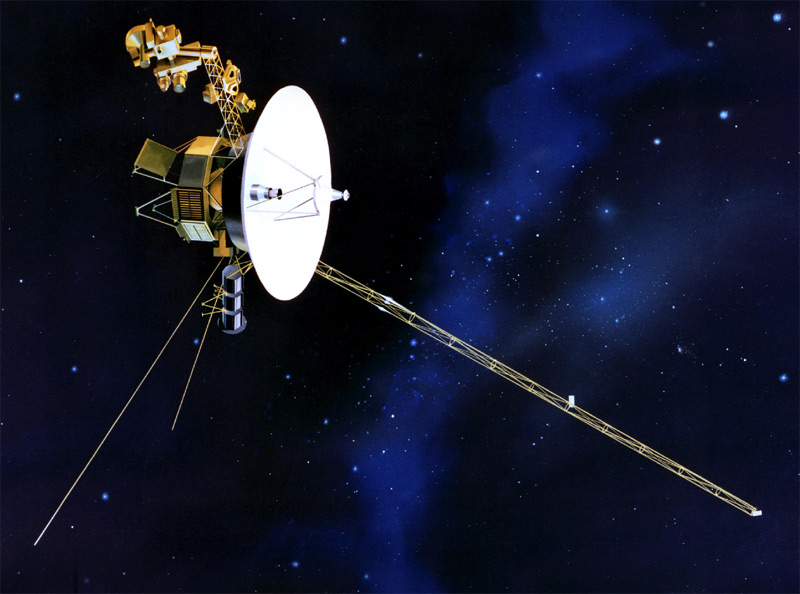[/caption]
She might be old, but she’s still got it where it counts. The 33-year old Voyager 1 probe, flying out near the edge of the solar system conducted a roll program, spinning 70 degrees counterclockwise, and held the position by spinning gyroscopes for two hours, 33 minutes. Voyager performed its in-flight gymnastics on March 7, 2011 and scientists hope the maneuver will help answer the question of which direction is the sun’s stream of charged particles turns when it nears the edge of the solar system.
“Even though Voyager 1 has been traveling through the solar system for 33 years, it is still a limber enough gymnast to do acrobatics we haven’t asked it to do in 21 years,” said Suzanne Dodd, Voyager project manager, based at NASA’s Jet Propulsion Laboratory. “It executed the maneuver without a hitch, and we look forward to doing it a few more times to allow the scientists to gather the data they need.”
Voyager needed to get in the right orientation to enable its Low Energy Charged Particle instrument to gather data.
The last time either of the two Voyager spacecraft rolled and stopped in a gyro-controlled orientation was Feb. 14, 1990, when Voyager 1 snapped a family portrait of the planets. See the image here.
The two Voyager spacecraft are traveling through a turbulent area known as the heliosheath,the outer shell of a bubble around our solar system created by the solar wind. The solar wind is traveling outward from the sun at a million miles per hour. Scientists think the wind must turn as it approaches the heliosheath where it makes contact with the interstellar wind — , which originates in the region between stars.
In June 2010, when Voyager 1 was about 17 billion kilometers (about 11 billion miles) away from the sun, data from the Low Energy Charged Particle instrument began to show that the net outward flow of the solar wind was zero. That zero reading has continued since. The Voyager science team doesn’t think the wind has disappeared in that area, but perhaps has just turned a corner. But where does it go from there: up, down or to the side?
“Because the direction of the solar wind has changed and its radial speed has dropped to zero, we have to change the orientation of Voyager 1 so the Low Energy Charged Particle instrument can act like a kind of weather vane to see which way the wind is now blowing,” said Edward Stone, Voyager project manager. “Knowing the strength and direction of the wind is critical to understanding the shape of our solar bubble and estimating how much farther it is to the edge of interstellar space.”
Voyager engineers performed a test roll and hold back on Feb. 2, just to make sure the spacecraft was still capable. No problems for the old girl, and spacecraft had no problem in reorienting itself and locking back onto its guide star, Alpha Centauri.

There will be five more of these maneuvers over the next seven days, with the longest hold lasting three hours 50 minutes. The Voyager team plans to execute a series of weekly rolls for this purpose every three months.
Over the next few months, scientists will analyze the data.
“We do whatever we can to make sure the scientists get exactly the kinds of data they need, because only the Voyager spacecraft are still active in this exotic region of space,” said Jefferson Hall, Voyager mission operations manager at JPL. “We were delighted to see Voyager still has the capability to acquire unique science data in an area that won’t likely be traveled by other spacecraft for decades to come.”
Voyager 2 was launched on Aug. 20, 1977. Voyager 1 was launched on Sept. 5, 1977. On March 7, Voyager 1 was 17.4 billion kilometers (10.8 billion miles) away from the sun. Voyager 2 was 14.2 billion kilometers (8.8 billion miles) away from the sun, on a different trajectory.
The solar wind’s outward flow has not yet diminished to zero where Voyager 2 is exploring, but that may happen as the spacecraft approaches the edge of the bubble in the years ahead.
Voyager is just another good old girl.
Source: JPL


USA, USA, USA…!!!!
That’s too cool. Even old, old space tech is still being used in exciting ways.
One nit to pick:
“The Voyager team plans to execute a series of weekly rolls for this purpose every three months.”
…wait. what?
“Now a pirouette. That’s a good girl!”
Simply amaaazing!!! I hope I’m not to old when she arrives at
Alpha Centauri…:-)
Oh…Mr. Larsson, what means the letters OM in your name.
Thanks for taking the time to answer.
No problem, it’s my web distinction/brag trapOrder of the Molly award.
Thanks for giving me the opportunity to brag! 😉
Interesting picture (concept) – I wonder what will happen once we leave the bubble. Maybe the probe will “magically” start accelerating and surfing on forces not yet known to man 😀
I was just wondering if someone could fill me in on what effect (if any) the Ort Cloud or the “Local Fluff” (I think thats what it is called) will have on the two Voyagers as they progress into interstellar space. I am still a novice at this.
Thanks!
Most probably, none at all.
What could possibly, but highly improbably happen would be an impact.
Just remember that the Voyagers and a number of other probes have crossed the asteroid belt where the average density is much higher than in the (still hypothetical btw) Oort cloud.
Thanks for the reply, Manu. I do have a couple of follow up questions though.
1> Will the Voyagers be able (to any degree) to confirm or deny the existence of the Oort cloud.
2> I have read that the Local Interstellar Cloud “contains a wispy mixture of hydrogen and helium atoms at a temperature of 6000 C”. If this is somewhat true, how would the Voyagers moving through it affect them?
Thanks for your patience!
You’re welcome! Good questions anyway. I’m answering without researching them, so don’t take the answers too seriously!
1: no. To do so, there would have to be an official mission for it, with them actively searching, transmitting data over the DNS, scientists actively studying the data, and a budget to pay for it.
Technically, I don’t think they could anyway, their cameras wouldn’t be sensitive enough to do better than present Earth-based telescopes. Even at Neptune the light level was challenging, and they’re now 3 or 4 times further away which means at least 10 times less light.
2: it would not. That gas density is so low that it’s an almost perfect vacuum by earth standards. The ‘vacuum’ they’ve been moving in when they were in the early years of their missions was closely packed with hot atoms by comparison: the solar wind!
I have a question that if someone could answer I would appreciate it. What is the name of the ‘Bow Shock’ looking extended bubble just outside of the circlular area (Helio-Sheath?) in front of the probes? It has bright colored streamers wrapped around it’s leading edge if that helps.
Actually, it IS called Bow Shock 🙂
This article also reminids me of yet another book I read as a teenager, Murmurs of Earth. Man that was another book that helped change my perspective and also was a leading cause for my becoming an Athiest.
I have never looked back.